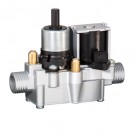Although modern gas heating systems operate efficiently and ecologically, new concepts are, nevertheless, called for in view of rising energy prices and more diverse raw material sources. For reasons of cost and to avoid shortages, gas is now increasingly being obtained from new suppliers. This can result in fluctuations in the gas composition, which in turn requires complex adjustment of the gas mixers to the particular calorific values of the gas currently being supplied in the case of conventional gas heating systems. A new gas valve with stepper motor control and electronic actuation now performs automatic adaptation to the quality of the gas. This permits rapid set-up of the heating system and at the same time avoids subsequent extra costs resulting from changes in the gas quality.
Similarly to a car engine, a heating system only provides optimum performance when operating with a narrowly defined air-to-fuel ratio. In the case of natural gas, the so-called Lambda value (the gas-to-air ratio) is in the region of 1.3. The nitrogen content fluctuates considerably depending on the gas field and the amount of biogas fed in. Conventional mechanical mix regulators cannot provide compensation for such fluctuations and so have to be re-adjusted. By contrast, the new gas valve F01 from ebm-papst Landshut offers a convenient way of dealing with the problem of adjustment to different gas qualities: Electronic control obviates the need for manual setting. An ideal, economical, and ecological combustion process is always guaranteed.
Natural gas from a variety of sources
As a result of liberalisation of the gas market, gas companies are now obliged to allow other suppliers to pump gas through their networks. Potential shortages are avoided by mixing gas from various fields or feeding in biogas. The calorific value of the resultant gas mix often fluctuates considerably despite the limit values agreed upon by the gas companies. The consequence of this for the combustion process is that the amount of combustion air required has to be adjusted. In practice, switching from high-calorific (so-called H gas) to low-calorific natural gas (L or even LL gas) for instance results in heat output losses of a double figure percentage magnitude if the mixture ratio is not adapted accordingly.
This is also associated with an increase in the pollutant emissions of the heating system. A conventional gas and air modulation system with mechanical/pneumatic control is not able to accommodate such fluctuations and manual adjustment is, therefore, always necessary. By contrast, the new electronic combustion control system provides constant automatic regulation by way of the gas valve (Fig. 1) to ensure optimum fuel utilisation.
Electronically controlled
The microprocessor-controlled system registers the combustion quality and ensures optimisation regardless of the installation location and the amount of heat required. This is based on three important parameters: Heat requirement, air mass flow, and gas quality. The air mass flow is set on the basis of the amount of heat required, as it is proportional to the output. A mass flow meter integrated into the fan measures the air throughput. With standard pre-mix burners, the composition of the gas can easily be detected thanks to a particular property of gases: Given identical thermal load and excess air (same Lambda value), all the gases within one gas family exhibit identical temperatures at the burner.
This permits reliable regulation of optimum combustion with a constant Lambda value as a function of the temperature at the burner and the combustion air mass flow. Depending on the heating system concerned, the excess air can, thus, be kept constant over the entire heater modulation range. This does, however, presuppose accurate and rapid regulation of the gas flow as specified by the electronics.
Gas valve as actuator
To be able to react accordingly to the information received, the new gas valve F01 is equipped with a stepper motor. The deterministic behaviour of the motor – one pulse corresponds to one step – simplifies the control action with no detriment to accuracy and safety. In practice, the new valve permits a control ratio of 1:10 as opposed to the standard 1:4 provided by pneumatic modulation to date. The valve reliably regulates gas quantities in the range between 1 and 40 kW rated output.
In extreme cases this control capacity makes it possible to reduce the heat output from 20 kW rated output to just 2 kW heat output for example if only minimal heating is required. Frequent burner start-up is, thus, avoided. Shorter shutdown times increase the efficiency of the heating system whilst at the same time reducing pollutant emissions.
The modular gas valve (Fig. 2a, 2b) combines proven safety technology with a modern electronically compatible actuator, the stepper motor with pressure regulator. The design is simple: Downstream of the safety valve, the gas flows to the valve disc. This is precisely raised or lowered by the stepper motor as specified by the control system, thus, accurately metering the flow of combustion gas. The new gas valve also simplifies the commissioning of gas heating systems.
Constant monitoring and adjustment not only provide compensation for fluctuations in the calorific value of the combustion gas. The system also automatically senses the altitude of the installation location and accordingly adjusts the quantity of gas and the combustion air flow required. There is then no need for time-consuming heating system setting work on site.



Ooh, interesting! I didn’t even know that some newer gas valves that use stepper motor control and electrical actuation adjust themselves automatically to the gas quality. Speaking of, my cousin has been getting busy lately remodeling his restaurant and the main gas line needs to be fixed. I hope he reads this info so he can get the right valve supply shortly.